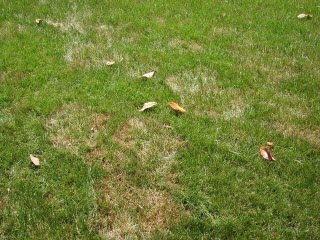A common misconception with homeowners is that if you properly fertilize your lawn, you will eliminate any turf issues. In fact, that reasoning makes sense. If you take all of the proper steps to maintain a healthy lawn, you should have no worries about turf disease. Unfortunately, this problem can still hit your lawn and can lead to costly repairs if left uncorrected over time.
What is Turf Disease?
 First, let me tell you what turf disease is not. Weeds like crabrass are simply plants that grow where you want them to; not turf disease. Most commonly, disease is caused by fungi and nematodes. Fungi are spread by spores and may cause root rot. Nematodes are commonly called roundworms and feed on the roots.
First, let me tell you what turf disease is not. Weeds like crabrass are simply plants that grow where you want them to; not turf disease. Most commonly, disease is caused by fungi and nematodes. Fungi are spread by spores and may cause root rot. Nematodes are commonly called roundworms and feed on the roots.
Some other problems that resemble diseases are caused by environmental or management factors such as cold, heat, drought, high soluble salts, soil compaction, or chemical damage. Careful identification of the cause of a problem is important for the selection of proper control methods.
One of the most common types of turf disease is brown patch. Brown patch as it is commonly called, looks like dying or over-watered patches of grass with its tan, brown, or yellow appearance. Symptoms appear between May and September, appear as irregular circular patches, and may have dark “smoke” rings around the edges in wet turf. Hot, humid weather, over watering, and high nitrogen fertilization are the main causes of brown patch.
If you want to treat the disease yourself, there are over-the-counter fungicides that you can apply with a typical longevity of 7-10 days. You can also hire Indy Lawn Pro to apply a treatment that is longer-lasting. The weather will dictate the number of treatments necessary to eliminate the disease, especially humid weather, but typically two or three controlled treatments are necessary to kill the fungus.
Can you prevent turf disease?
If your grass has been affected by turf disease before, it is more susceptible to reappearance each year. Also, properties with lots of trees with shade and limited sunlight and stagnant air patterns are more susceptible to turf disease. On the other hand, free-flowing air properties typically do not develop turf disease.
If left untreated, it can spread in hot temperatures and humidity conducive to its spread, but will likely disappear over time once temperatures in the evening reach 65 degrees or below, regardless of the humidity or daytime heat. In some cases, it can kill your grass.
Equipping yourself about your choices is the best way to make informed decisions about your lawn.

Leave a Reply